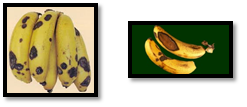Authors: PATEL SANKETKUMAR VIKASHBHAI
1. Introduction
- It is an important post-harvest problem of bananas especially during transport and storage.
- Infection in young fruit is not always manifested until the fruit ripens (latent Infection)
- Colletotrichum musae (Berk. & M.A. Curtis) Arx. - Acervuli with black setae (Asexual fruiting structure), conidia (hyaline, aseptate, oval to elliptical or straight cylindrical, guttulate.) forming fungal pathogen (Anamorphic stage)
- Gloeosporium musarum (Cke. and Massee) (Teleomorphic stage)

3. Symptomatology
- Infection starts at the distal end of the young harvested fruits, small, circular, black spots develop on the affected fruits. Then these spots enlarge in size (about 8 x 3 cm), turn to brown colour.
- The skin of the fruit turns black and shrivels and becomes covered with characteristic pink acervuli. Finally the whole finger is affected. Later the disease spreads and affects the whole bunch.
- The disease results in premature ripening and shriveling of the fruit? which are covered with pink spore masses
- Occurrence if black lesions on the pedicel causes withering of the pedicel and dropping of the fingers from the hands.
- Sometimes the main stalk of the bunch may become diseased. Infected fruits become black and rotten
• Survival and Dispersal: The spread of the disease is by air-borne conidia and numerous insects which frequently visit banana flowers also spread the disease
• Conducive factors: The disease is favoured by high atmospheric temperature and humidity, wounds and brusies caused in the fruit and susceptibility of the variety
5. Integrated management practices:
Banana fruits should be handled carefully at all times to avoid bruising or other injuries. To deter postharvest diseases, growers and marketers should adopt the following practices.
- Regulatory methods : Use only diseased-free planting materials
-
Cultural methods:
-
Proper selection of planting materials
- Proper orchard sanitation - Once per week, Remove and destroy infected parts but avoid touching other plant parts, especially when these are wet Harvest unripe but mature fruits.
-
Keep area free of weeds
- Physical methods: Treat the fruit with hot water for 5 min at 50°C.
- Biological methods: Spray bunches twice with Pseudomonas fluorescens @ 0.25% or Bacillus subtilis @ 0.2%
-
Chemical methods:
- Spray bunches twice with copper oxychloride 0.25% or Bordeaux mixture 1% or Indofil M-45 or chlorothaloail 0.2% or Carbendazim 0.1% at fortnightly interval.
- Post harvest dipping of fruits in Aureofunginsol 100 ppm or Carbendazim 400 ppm or Benomyl 1000 ppm.
References:
Fruit crop diseases and their management, IIHR,
Bangalorejndia. www.agritech.tnau.ac.in/crop-protecrio
About Author / Additional Info:
I am studding in Ph. D. in plant pathology at Anand agricultural university,Anand.